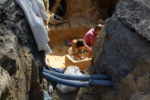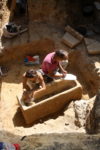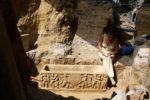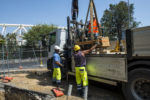 Workers installing new pipelines near Rome’s Olympic Stadium this summer uncovered two ancient Roman children’s’ sarcophagi. The ENEA utility company stumbled on the artifacts while digging in the Monte Mario neighborhood just behind the north curve of the stadium. They stopped the work and reported the find to the Special Superintendency for the Colosseum and the Archaeological Area of Central Rome which sent an archaeological team to excavate the site.
Workers installing new pipelines near Rome’s Olympic Stadium this summer uncovered two ancient Roman children’s’ sarcophagi. The ENEA utility company stumbled on the artifacts while digging in the Monte Mario neighborhood just behind the north curve of the stadium. They stopped the work and reported the find to the Special Superintendency for the Colosseum and the Archaeological Area of Central Rome which sent an archaeological team to excavate the site.
 The marble sarcophagi were found about eight feet below street level. One of them is rough hewn, the chisel marks clearly visible on the interior and exterior, while the other is decorated with a bas relief on the exterior. The relief depicts a central pair of erotes (Cupid-like figures also known as putti or cherubs) holding aloft a circular medallion that is either too eroded or too soil-encrusted to identify the image it bears. It was likely an image of the deceased called a clipeus portrait, or perhaps a mythological reference. Two small figures recline underneath the medallion. On the right and left sides of
The marble sarcophagi were found about eight feet below street level. One of them is rough hewn, the chisel marks clearly visible on the interior and exterior, while the other is decorated with a bas relief on the exterior. The relief depicts a central pair of erotes (Cupid-like figures also known as putti or cherubs) holding aloft a circular medallion that is either too eroded or too soil-encrusted to identify the image it bears. It was likely an image of the deceased called a clipeus portrait, or perhaps a mythological reference. Two small figures recline underneath the medallion. On the right and left sides of  the central scene are pairs of embracing Cupids and Pyches. Individual erotes cap the ends of the panel. Both it and the other, plainer sarcophagus were expensive luxury items that only the wealthy could afford. The children buried in them must have been from well-to-do families.
the central scene are pairs of embracing Cupids and Pyches. Individual erotes cap the ends of the panel. Both it and the other, plainer sarcophagus were expensive luxury items that only the wealthy could afford. The children buried in them must have been from well-to-do families.
Erotes were common motifs in funerary reliefs, particularly for children because they’re basically babies with wings. They continued to be used into the Christian era, reinterpreted as angels bringing ![]() the souls of the dead to heaven. The Metropolitan Museum of Art has a sarcophagus with very similar iconography to the one found near the stadium, although the clipeus portrait identifies the deceased as a young man, not a child.
the souls of the dead to heaven. The Metropolitan Museum of Art has a sarcophagus with very similar iconography to the one found near the stadium, although the clipeus portrait identifies the deceased as a young man, not a child.
 Preliminary examination suggests the sarcophagi date to the 3rd or 4th century A.D. — the Met’s sarcophagus dates to the late 2nd, early 3rd century and the more refined carving is indicative of an earlier date than the cruder art on the newly discovered one. The dating can’t be asserted with confidence until the objects have been subjected to further testing. Concerned that the open excavation pit was too easily accessible to vandals and looters, archaeologists decided to remove the sarcophagi from the site as soon as they could. They have been transported to the laboratories of the Special Superintendency to be cleaned, studied and conserved. The first dating results and other research will be published next fall.
Preliminary examination suggests the sarcophagi date to the 3rd or 4th century A.D. — the Met’s sarcophagus dates to the late 2nd, early 3rd century and the more refined carving is indicative of an earlier date than the cruder art on the newly discovered one. The dating can’t be asserted with confidence until the objects have been subjected to further testing. Concerned that the open excavation pit was too easily accessible to vandals and looters, archaeologists decided to remove the sarcophagi from the site as soon as they could. They have been transported to the laboratories of the Special Superintendency to be cleaned, studied and conserved. The first dating results and other research will be published next fall.